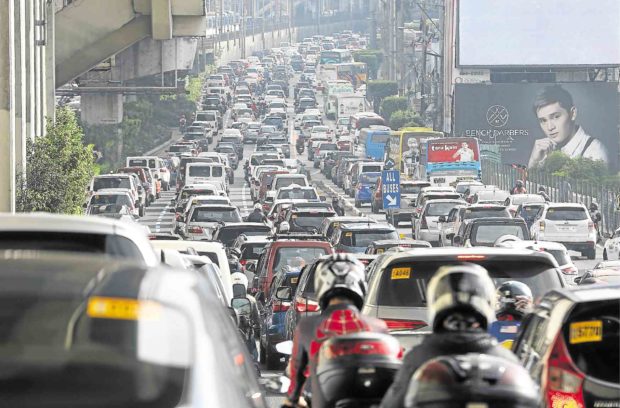The Department of Transportation (DOTr) was unable to fully implement P46.6 billion worth of funded projects due to frequent changes in policy, causing the transport problems in the country to persist, the Commission on Audit (COA) said.
The COA report on the DOTr for 2017 said these changes in “policy directions by political leaders and economic managers” resulted in the failed or delayed implementation of 153 out of 159 DOTr projects last year worth P58.9 billion.
“We recommend and [DOTr] agreed to improve the utilization of its allotment and cash allocations through timely implementation of programs and projects so as not to delay the completion and availability of the projects for public use,” the COA said.
The DOTr plays a crucial role in accelerating the country’s economic development and improving its competitive edge by providing the “backbone for growth” through “effective and efficient transportation infrastructure systems,” the COA said.
“In view of the department’s unutilized allotments and cash allocations, timely delivery of its mandated services, particularly the improvement of road safety by expanding safe, affordable and accessible public transport, was not achieved,” the state auditing agency said.
A large chunk of the unspent funds, about P1.1 billion, was part of the P2.5-billion botched contract for the production of vehicle plates and drivers’ licenses for the Land Transportation Office.
The COA said the projects that were funded but not implemented or only partially accomplished included the technical support consultancy project for the Cebu Bus Rapid Transit worth P2.4 billion; the P1.9-billion Light Rail Transit (LRT) Line 2 east extension; the P1.4-billion LRT Line 1 north extension common station; the improvement of the Cauayan airport for P298 million and Dumaguete airport for P185 million.
A total of P700 million worth of projects for regional airport expansions and maintenance, supposed to be undertaken through public-private partnerships, were hobbled because of the policy changes, according to the COA.
Independent audit
The DOTr also put on hold the Metro Manila Bus Rapid Transit Line 1-Quezon Avenue project, which had been provided a funding of P563.6 million, because officials supposedly could not decide on whether to push through with it, the COA said.
Delays were also caused by the late signing of memorandums of agreements for 58 projects, which were completed only in the last quarter of 2017.
The transport department, however, may have just shown prudence in not spending some of the funds, including the P279 million for the complete payment of the 48 China-made coaches for Metro Rail Transit 3 (MRT 3), which were bought by the Aquino administration.
Transportation Secretary Arthur Tugade earlier this month said an independent audit of the coaches that were meant to augment the existing MRT 3 fleet had been completed, but declined to disclose how many were found usable.
Tugade told reporters the coaches did not comply with the terms of reference for their purchase, but whether this was “substantive and prejudicial to the safety and comfort of passengers” still had to be determined.
No ‘structured plan’
As a result of being unable to operate the new light rail vehicles from China, another P213 million allocated for the MRT 3’s electricity consumption was not spent.
The DOTr also managed to save P135.6 million when it reduced the number of its security guards from 600 to 500.
The COA report noted that the DOTr lacked a “structured transfer plan” before it relocated its office operations to the Clark Economic Zone and Freeport in Pampanga.
As a result, the government lost P19.2 million in unrealized rentals from the 58 condominium units of the deserted DOTr offices at Columbia Towers in Mandaluyong CIty.
The rentals could have been used to offset the P5.7 million the DOTr spent to shuttle its employees from Manila to Clark, the COA said.
